





A "Beam Compass 26 inch" by Aston & Mander, dated 1917, made for the British Government. The lath is made of mahogany with an inlaid boxwood scale.
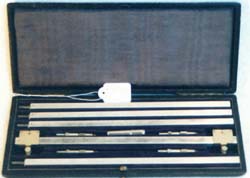
A mid-twentieth century beam compass. The four foot beam is in five, eight inch, aluminium sections. Both trammel heads are adjustable by a similar wheel and spring arrangement to that in one of the Norton & Gregory fittings below. A set of similar but larger fittings can be seen in the Harling page as well as a later version of this type.
W H Harling made this pattern of beam compass, which they called the “Roller Pattern Portable Beam Compass” and it is possible that they made this set.
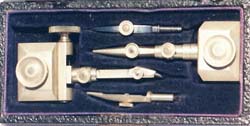
For drawing very large arcs and circles trammels were sold in sets for attaching to a wooden lath. These are known as the "Swiss Pattern" and it can be seen that the position of the insert in one can be finely adjusted by a screw. These are early to mid-twentieth century, by J J Threadwell, although unsigned.
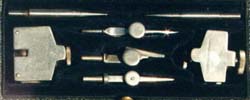
These beam compass fittings by Norton & Gregory are of the cheaper pattern, one clamped to the beam, and the other adjusted by a roller and spring arrangement.

A fine, brass beam compass by Gebruder Wichmann of Berlin, No.1070. The two section,septagonal beam is 43.5 inches long. It dates from about 1910. There is a screw for fine setting of the left hand trammel at the end of the beam.

A Lee Guinness beam compass with a five section alloy beam which is fifty inches long when fitted together. Lee Guinness were set up in Northern Ireland after World War II to make pirated Riefler designs.
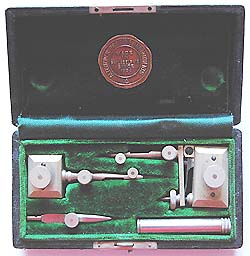
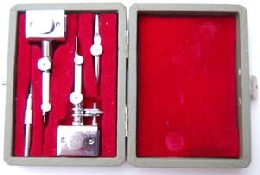
Super Takeda Drawing Instruments, Japan beam compass fittings. Plated metal. A cheap version of Swiss pattern fittings, the clamp outer is bent up from sheet rather than milled from solid and the clamps are smaller than usual with English or Continental fittings. The fine adjusting screw is also an unusual type. The box is covered in grey fabric and lined with red velvet.
Probably dates from 3rd quarter twentieth century.
Probably dates from 3rd quarter twentieth century.
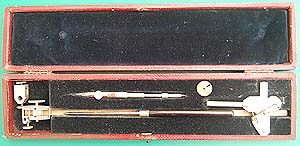
Beam compass by unknown maker. The case is covered with paper imitating morocco and lined with blue velvet. The beam is 10” long and 1/4” square. The dotting pen has two wheels and is missing a third at least. The fitting for the point is of the roller type but unusually is moved by a thumb screw. The pen/pencil insert is reversible and the mechanical dotting pen can also be placed in the fixed fitting. Possibly made in Germany.
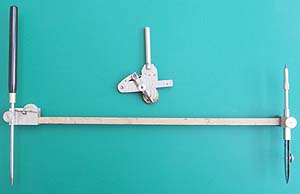
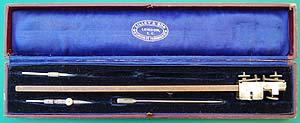
11” beam compass by Lilley & Son, 10 London St, Fenchurch St, London EC dating from ca.1900. The firm was in existence from 1846 to 1913, and at this address from 1890 to 1901 (address after 1901 not known).
Two pieces are missing, probably a needle point and a pen handle. Faux Morocco covered case lined with blue silk and velvet.
Two pieces are missing, probably a needle point and a pen handle. Faux Morocco covered case lined with blue silk and velvet.
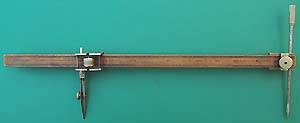
The Lilley beam compass ready for use with the ink point in place in the roller fitting. The beam compass is very similar to those made by some of the German manufacturers, such as E O Richter. The construction is however a little lighter than the one I have in an E O Richter set. Could it have been made in Germany for Lilley to retail?
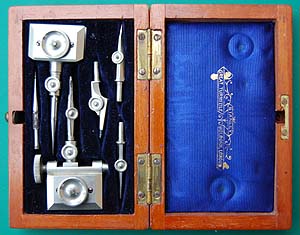

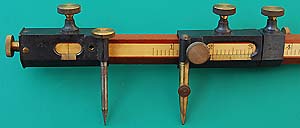
Woolwich pattern 26” beam compass no.790 made by Houghton-Butcher Manufacturing Co Ltd in 1917. The screw at the left hand end is to adjust the position of the fixed fitting to the zero mark on the beam. The moving fitting has a vernier with a clamp and slow motion screw for fine adjustment. It is missing pen and pencil points and a clamping screw. The beam is mahogany with an inlaid boxwood scale.
The varied selection of beam compasses and fittings includes aluminium, brass and wood beams and a variety of types of fitting. More beam compasses and fittings can be seen in the Major Makers pages for W H Harling, W F Stanley and Riefler.
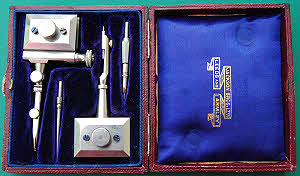
Set of beam compass fittings by Jackson of Armley and Leeds. The fittings appear to be of continental manufacture as are many of the instruments that Jackson sold.

Tubular electrum beam compass, 600 mm overall length, probably made in Germany ca. 1930. It is unusual in that the sliding trammel is locked to the beam by a collet arrangement. There is fine adjustment by a screw at the end of the beam. It has ink, pencil and two needle points.
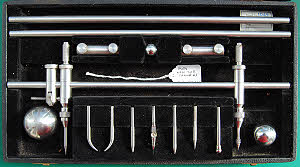
Engineer’s beam compass by Moore & Wright. It’s main use was for marking out on metal work pieces and it has a selection of calliper and scribing points for that purpose as well as needle, pencil and ink points for drawing. The balls are for seating into holes to mark out from them. The instrument is stainless steel and the three solid beam sections are joined by the sleeves with two clamping screws. It probably dates from the 1960s. Black leatherette covered case. Beam length approximately 36 inches (900 mm)
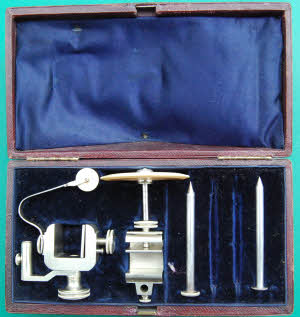
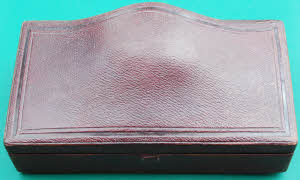
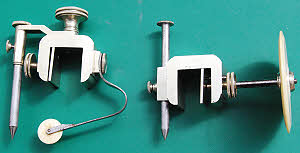
A most unusual set of electrum beam compass fittings, probably English. The fitting on the right is the one the beam pivots about and has a two inch diameter ivory castor wheel. The left hand fitting is the one that rotates to draw the arc. The pencil and pen fittings that locate in this fitting are missing. The small ivory castor wheel is mounted on a spring so the drawing point can be pressed onto or lifted clear of the drawing. The beam recess is of massive cross section, 1.6cm wide by 2cm deep so the instrument was presumably for drawing very large radius arcs. W F Stanley did not favour beam compasses with castor wheels, considering them unnecessary. I now know that the right hand fitting should be mounted on the underside of the beam which would be about 4cm deep. Thus it is upside down in the bottom left picture and the point should be inserted in the other direction. A deep beam would then be horizontal with the left fitting on top and the right one under. I have used it with a pencil (turned to fit) in the left hand fitting and home made beam and the instrument is totally self supporting and does not need to be held at the pivot end, so can be used with a very long beam.
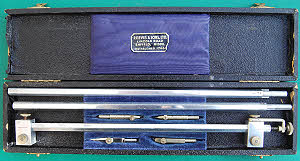
Beam compass set retailed by Reeves & Sons Ltd. The main components are aluminium with electrum fittings. The beam is 30 inches long. This set was made by J J Threadwell. It can be found with various retailer’s names on it.
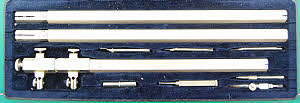
Wichmann 750mm electrum beam compass with septagonal section beam. This “System Wichmann” beam compass has a similar section beam to the brass one shown earlier but the inserts are a later pattern. It dates from the 1930s/40s.

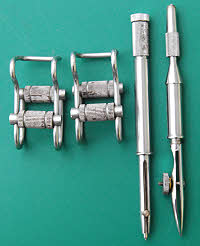
Beam compass fittings of the roller adjustment type, maker unknown. Appears to be stainless steel. Appears in both B J Hall & Co and C Baker catalogues from the 1930s, called in the latter “wire roller pattern”. The mahogany lath is a replacement that I have made.

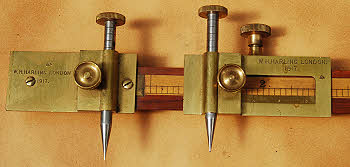
“Beam Compass 52 inch” by W H Harling with broad arrow marks and dated 1917. It is complete with its pen and pencil lead points stored in the centre fixture. The box is pine.


Lee Guinness 52 inch beam compass ex government W10/WK/00055 comprising two anodised aluminium alloy 26” beams, two roller trammels, ink, pencil, needle and plain points. 1940s/1950s date.
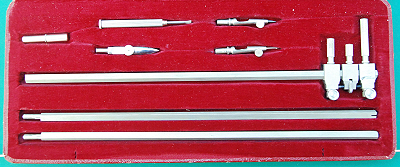
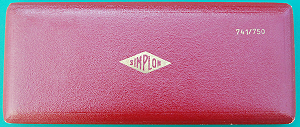
Simplon 741/750 thirty inch beam compass made in West Germany. It appears to be made
of stainless steel as it is non-
| Early Sets |
| Traditional Sets |
| Later Sets |
| Major Makers |
| Instruments |
| Miscellanea |
| W F Stanley |
| A G Thornton |
| W H Harling |
| Elliott Bros |
| J Halden |
| Riefler |
| E O Richter |
| Kern, Aarau |
| Keuffel & Esser |
| Compasses |
| Pocket compasses |
| Beam compasses |
| Dividers |
| Proportional dividers |
| Pens |
| Pencils |
| Rules |
| Protractors |
| Squares |
| Parallels |
| Pantographs |
| Sectors |
| Planimeters |
| Map Measurers |
| Miscellaneous |
| Materials Used |
| Who made them |
| Who made these |
| Addiator |
| Addimult |
| Other German |
| USA |
| Miscellaneous |
| Microscopes |
| Barometers |
| Hydrometers & Scales |
| Pedometers |
| Surveying Instruments |
| Other instruments |
| Workshop Measuring Tools |
| Catalogues & Brochures |
| Levels & Theodolites |
| Compasses & Clinometers |
| Miscellaneous surveying |
| Micrometers & Verniers |
| Engineering rules and gauges |
| Wood rules & calipers |
| Dial gauges & miscellaneous |